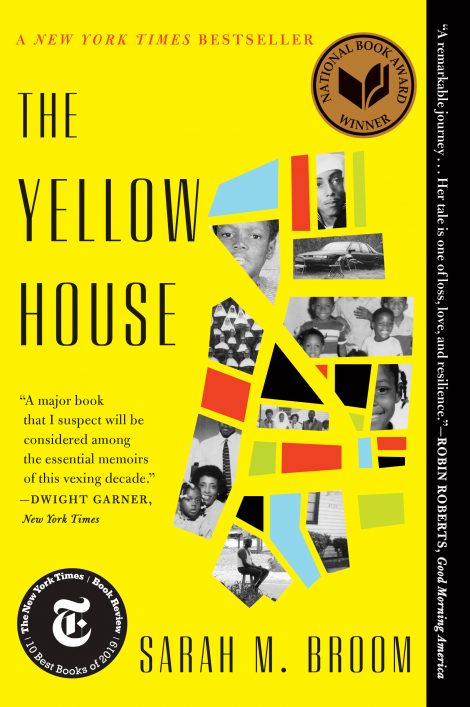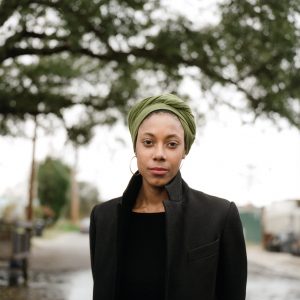
THE YELLOW HOUSE
Winner of the 2019 National Book Award in Nonfiction, The Yellow House is a brilliant, haunting and unforgettable memoir from a stunning new talent about the inexorable pull of home and family, set in a shotgun house in New Orleans East.
A book of great ambition, Sarah M. Broom’s memoir tells a hundred years of her family and their relationship to home in a neglected area of one of America’s most mythologized cities. This is the story of a mother’s struggle against a house’s entropy, and that of a prodigal daughter who left home only to reckon with the pull that home exerts,
Winner of the 2019 National Book Award in Nonfiction, The Yellow House is a brilliant, haunting and unforgettable memoir from a stunning new talent about the inexorable pull of home and family, set in a shotgun house in New Orleans East.
A book of great ambition, Sarah M. Broom’s memoir tells a hundred years of her family and their relationship to home in a neglected area of one of America’s most mythologized cities. This is the story of a mother’s struggle against a house’s entropy, and that of a prodigal daughter who left home only to reckon with the pull that home exerts, even after the Yellow House was wiped off the map after Hurricane Katrina. The Yellow House expands the map of New Orleans to include the stories of its lesser known natives, demonstrating how enduring drives of clan, pride, and familial love resist and defy erasure.
- Grove Press
- Paperback
- June 2020
- 400 Pages
- 9780802149039
About Sarah M. Broom
 Sarah M. Broom is a writer whose work has appeared in the New Yorker, The New York Times Magazine, The Oxford American, and O, The Oprah Magazine among others. She was awarded a Whiting Foundation Creative Nonfiction Grant in 2016 and was a finalist for the New York Foundation for the Arts Fellowship in Creative Nonfiction in 2011. She has also been awarded fellowships at Djerassi Resident Artists Program and MacDowell. She lives in New York.
Sarah M. Broom is a writer whose work has appeared in the New Yorker, The New York Times Magazine, The Oxford American, and O, The Oprah Magazine among others. She was awarded a Whiting Foundation Creative Nonfiction Grant in 2016 and was a finalist for the New York Foundation for the Arts Fellowship in Creative Nonfiction in 2011. She has also been awarded fellowships at Djerassi Resident Artists Program and MacDowell. She lives in New York.
Praise
“A major book that I suspect will come to be considered among the essential memoirs of this vexing decade.” —New York Times
“Gorgeous…reads as elegy and prayer…Sarah M. Broom is a writer of great intellect and breadth.” —NPR
“A remarkable journey… Her tale is one of loss, love, and resilience.” —Robin Roberts, “Good Morning America”
“An extraordinary, engrossing debut…[Broom] pushes past the baseline expectations of memoir as a genre to create an entertaining and inventive amalgamation of literary forms. —New York Times Book Review
Discussion Questions
On perspective:
At the opening of the story, Sarah Broom describes the lot where the Yellow House once stood from fifteen thousand feet above, saying that from those great heights, her brother Carl, who tends the space, would not be seen.
Have you ever brought up a Google Earth image of your house from above and zoomed out? What impact did seeing your home, your street, your state, your country shrink in comparison to the world have on your perspective?
On names:
The author refers to Hurricane Katrina throughout as “the Water.”
Why do you think she made this choice? Describe what “the Water” communicates to you, and how it changed over the course of the book. Do you think it will be the same for every reader?
On family firsts:
On p. 57, Broom writes: “Mom paid for her house with money from Webb’s life insurance policy. She was nineteen years old, the first in her immediate family to own a house, a dream toward which her own mother, Lolo, still bent all of her strivings.”
Who accomplished these kinds of firsts in your family? Were they long-ago accomplishments or more recent? What kinds of sacrifices or good-willed pitching in were made and by whom to help make them possible?
On the growing-up world:
In the chapter “Map of My World,” the author describes five points on the map that make (p. 117) “my growing-up world.”
What are some of the places that you can still inhabit vividly in your mind’s eye? Why do you think those stuck and not others? Why do you think the points in the author’s growing-up world stuck with her so strongly?
On the long-term impact of catastrophe:
During the Water, Broom writes, “All told, we scatter in three cardinal directions, nine runny spots on the map.” Even after it recedes, most remain dispersed. How do climate events like the hurricane impact families, employment, housing prices? What effect do you think this kind of scattering after climate crises has on regional culture?
